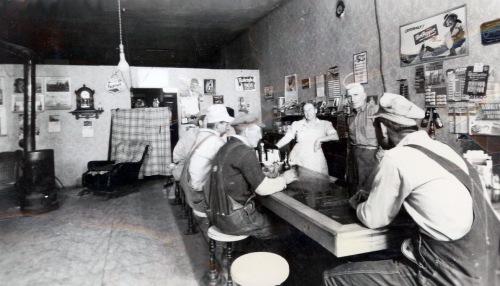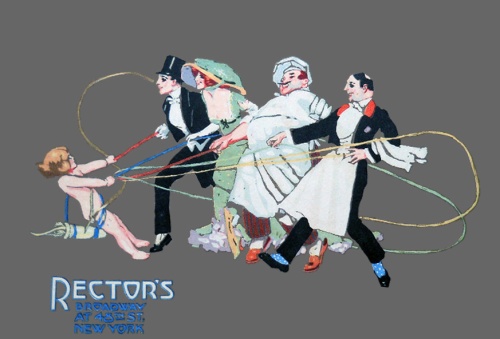Before restaurants adopted the expression, it was used by churches, with a double meaning that referred both to dress and to the shame of past deeds.
However, in restaurants it simply meant that patrons could wear their everyday casual clothes.
In the hospitality field, the slogan took hold first in the West. In the teens and 1920s, it was commonly used by hotels and resorts. It may seem odd that a resort where people swim, golf, and play tennis would require women to wear dresses and men to wear jackets to dinner, but that was not uncommon in the 1920s, especially in the East. In fact, the custom can still be found today, but it stands as a quaint re-enactment of past times as much as anything.
The western attitude toward casual dress in hotels, resorts, and restaurants spread slowly and was not without some resistance. Oddly, it met the greatest resistance from a business operating in the West: the Fred Harvey company that ran eating houses for the Santa Fe railroad.
The Harvey company required men to wear jackets in its dining rooms – even before electric fans and regardless of hot weather. If a man refused to wear a jacket, he would be served only at an adjoining lunch counter. In the early 1920s the Harvey company fought an Oklahoma Corporation Commission decision that threw out Harvey’s jacket rule. But Oklahoma’s supreme court ruled in favor of Harvey, declaring that the company had the right to require jackets. “Unlike the lower animals, we all demand the maintenance of some style and fashion in the dining-room,” said the decision.
Full-scale formal dress – white tie and tails for men and women wearing long evening gowns – was never common in this country. Nonetheless etiquette advisors who wrote for women’s magazines liked to suggest the opposite, flattering (and confusing) their readers with rules followed only by the upper, upper reaches of high society. However, even if formal wear was rarely necessary, there was an expectation that diners in a nice restaurant or hotel dining room would at least wear what we now refer to as business attire. The St. Regis Hotel in New York City advertised widely in 1908 that it was a comfortable, homey hotel opposed to snobbish dress rules, yet making it clear that “The wearing of a business suit bars no one from admission or service.”
As widely as she was published and read, etiquette maven Emily Post never seemed to be in tune with most Americans. During the depths of the Depression she continued to insist that women should wear suits, hats, and gloves to a restaurant lunch and dinner dresses in the evening. Even at a summer resort, she declared, women should wear cover-up shoes when dining out. “Bare-toed sandals with evening dresses are too revolting to mention,” she wrote.
Following World War II as young families were established and the suburbs spread, things began to change radically. The restaurant industry realized that finding a babysitter or dressing up the whole family was a barrier to restaurant going for many. Instead families were turning to informal roadside places. “Drive-ins, with their motto of ‘Come as You Are, Eat in Your Car,’ have a siren call for parents with insoluble sitter problems,” observed the Cleveland Plain Dealer in 1960.
Chains also got the message. A 1963 Bonanza advertisement proclaimed low-priced steak dinners plus “No tipping – Children ½ price – Come as you are – Western atmosphere.”
 Meanwhile, in the late 1960s, in the midst of the hippie upheaval, Gloria Vanderbilt recommended the “little black dress” as always correct for dining in a fine restaurant. But informality was winning as women wearing pants gained acceptance even in luxury New York City restaurants in the early 1970s, a rule change stimulated no doubt by a damaging recession.
Meanwhile, in the late 1960s, in the midst of the hippie upheaval, Gloria Vanderbilt recommended the “little black dress” as always correct for dining in a fine restaurant. But informality was winning as women wearing pants gained acceptance even in luxury New York City restaurants in the early 1970s, a rule change stimulated no doubt by a damaging recession.
By the late 1970s dress codes had been relaxed to the point that many upscale restaurants were minimally satisfied if their customers at least wore “dressy casual,” which usually meant designer jeans, shirts with collars, and no short-shorts, tank tops, or halter tops. Some chains accepted t-shirts as long as they weren’t white, but everyone agreed that patrons had to wear some kind of shirt and shoes.
Today, as Alison Pearlman has written in her fine book Smart Casual, the bond between fancy formal restaurants and gourmet dining has been loosened further by affluent young professionals in the creative industries. If they wear hoodies and jeans to work they expect to do the same as they sample innovative dishes at a hip restaurant.

And yet, along with the relentless trend toward casual dress, the tendency to show off in public persists, possibly as strongly as in the late 1890s when women of New York’s “smart set” took to the cafes to display the latest fashions.
© Jan Whitaker, 2016



















 It's great to hear from readers and I take time to answer queries. I can't always find what you are looking for, but I do appreciate getting thank yous no matter what the outcome.
It's great to hear from readers and I take time to answer queries. I can't always find what you are looking for, but I do appreciate getting thank yous no matter what the outcome.


